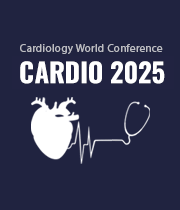Title : A rare presentation of missed constrictive pericarditis due to coxiella burnetii
Abstract:
Introduction: Constrictive pericarditis is a rare disease where calcification of the pericardium leads to restricted diastolic filling of the heart. Due to its non-specific symptoms, such as dyspnea with exertion, peripheral edema, and chest discomfort, it can mimic many primary pulmonary and cardiac disorders. The most common cause is viral infections, but Q fever caused by the bacteria Coxiella burnetii has rarely been described in the literature. We present an elderly male farmer who initially presented with dyspnea on exertion attributed to chronic obstructive pulmonary disease (COPD) and atrial fibrillation. Despite cardioversion to sinus rhythm and treatment for COPD exacerbation, his symptoms did not improve. Subsequent imaging and cardiac catheterization confirmed constrictive pericarditis. The workup revealed positive Coxiella burnetii titers consistent with chronic Q fever as the primary etiology.
Case Description: A 74-year-old male with a history of COPD and atrial fibrillation presented with worsening dyspnea on exertion for months. Upon review of records, the patient was hospitalized multiple times for similar symptoms and treated for pneumonia and COPD exacerbation with no improvement. On presentation, the patient was tachycardic in atrial fibrillation and saturating at 92% on 4-liter nasal cannula. The physical examination was unremarkable. The patient had a cardioversion converting into normal sinus rhythm with no improvement in symptoms. A review of imaging from a prior hospitalization revealed pericardial calcifications. A Doppler echocardiogram was obtained, which showed abnormal septal ventricular motion, steep deceleration time with mitral inflow, and reversal of normal annular tissue Doppler velocity consistent with constrictive pericarditis. The decision was made to proceed with right and left heart catheterization for further evaluation. Left heart catheterization did not reveal significant obstructive coronary artery disease. However, right heart catheterization showed evidence of constriction, with every 4-5 beats displaying discordance with right atrial pressures without respiratory variation and exaggerative y descents, consistent with constrictive pericarditis. Cardiac magnetic resonance imaging (CMR) showed a 6-7 mm thickened pericardium with constrictive physiology evidenced by diastolic septal bounce and intraventricular dependence. Due to the etiology being unclear, labs including ESR, CRP, ANA, ANCA, cocci, tuberculosis, Histoplasma galactomannan antigen, Coxiella burnetii, CMV, EBV, HIV, Hepatitis B, and Hepatitis C were obtained. The notable results were a high Coxiella burnetii positive IgG phase I titer confirmed on repeat serology consistent with chronic Q fever. The patient was transferred for pericardiectomy.
Discussion: Constrictive pericarditis can masquerade as primary cardiac or pulmonary disorders, resulting in delayed diagnosis and treatment. Maintaining a high level of suspicion for constrictive pericarditis is crucial, especially in patients in which standard treatment fails to yield sufficient symptom relief. While cardiac catheterization remains the gold standard, multimodality imaging such as Doppler echocardiogram and CMR should be used initially as the noninvasive modality of choice for the timely diagnosis of constrictive pericarditis. The predominant etiology is idiopathic, but chronic Q fever can be underdiagnosed as there can be an inadequate serological response and a delay in exposure and onset of symptoms.



